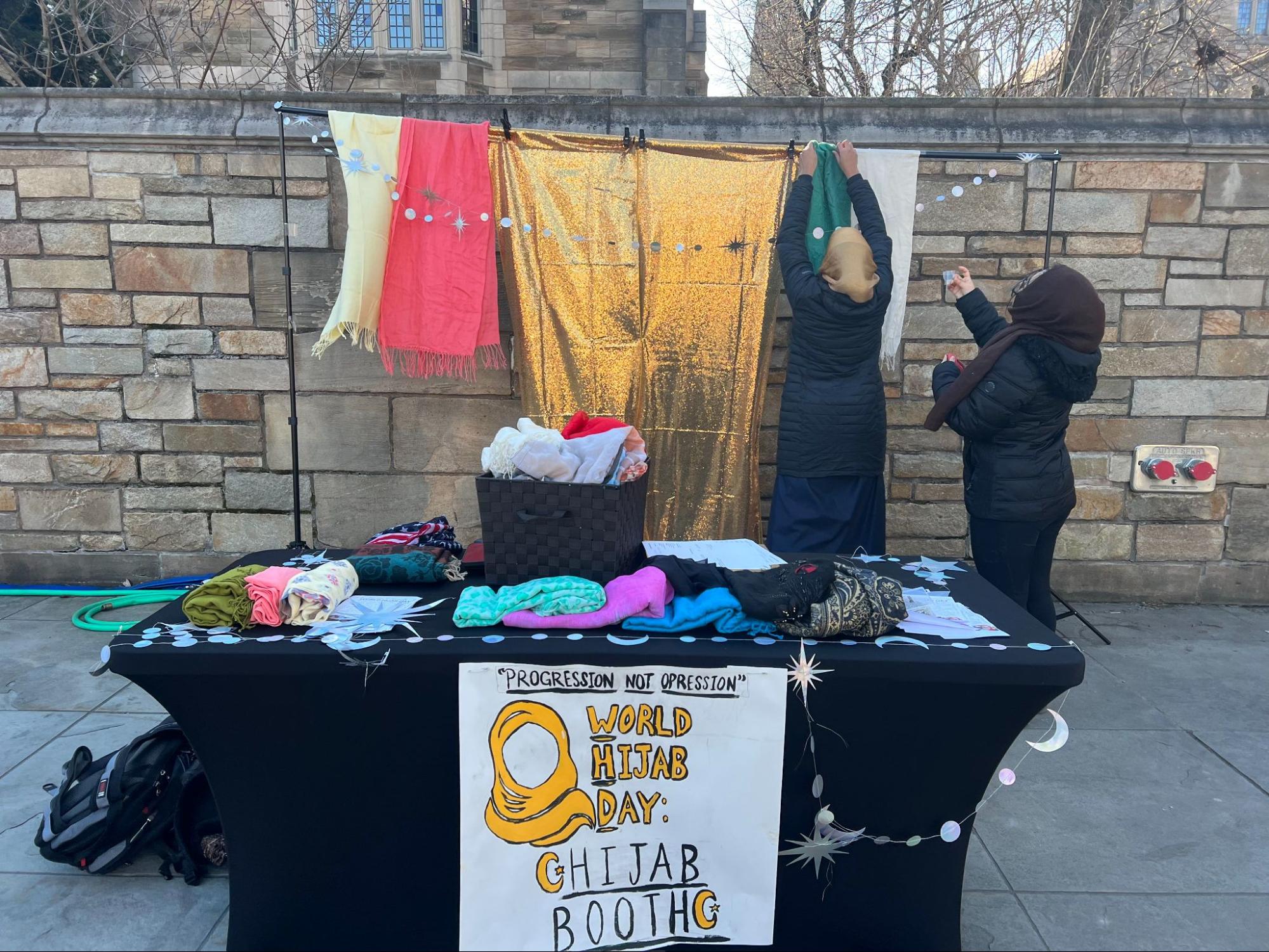Muslim Students Association and Yale Women’s Center celebrate World Hijab Day
Students from Yale’s Muslim Students Association worked with the Yale Women’s Center to set up a booth on Cross Campus for World Hijab Day on Feb. 1.

Courtesy of Zahra Yarali
The Muslim Students Association and Yale Women’s Center joined forces to celebrate World Hijab Day on Feb. 1, joining communities in over 150 countries that also spent the day celebrating and promoting understanding of the hijab.
Members of both organizations set up a booth on Cross Campus from 10:00 a.m. to 4:00 p.m. At the booth, MSA members shared baklava and taught passersby about the hijab’s history. Guests were also welcomed to try on hijabs that the volunteers had brought from the Muslim prayer space on campus.
“The most meaningful part of the event for me was seeing all the photos taken at the hijab booth flood in and hearing about the various conversations that people had on their own shifts at the table,” MSA Political Chair Ilham Abdelkadir ’25 wrote in an email to the News. “Muslim women were able to bring awareness to how women today are facing discrimination on both sides of the spectrum: because of choosing to wear hijab and because of choosing not to.”
Huda Siddiqui ’25, a YWC staffer and volunteer coordinator for last week’s WHD programming, told the News that five to seven students stopped by their booth each hour.
For Abdelkadir and MSA member Fatima Kamara ’25, the day’s most impactful aspect was non-hijabi attendees trying on the hijab.
“I think the most meaningful part of the event was getting people to try on the hijab,” Fatima Kamara ’25 said. “To me that represents how a piece of clothing provides not just freedom of expression but also a sense of solidarity/unity between women.”
World Hijab Day was founded in 2013 by Nazma Khan. When Khan moved to New York from Bangladesh at eleven years old, she was the only hijabi in her middle school.
Khan echoed the sentiments of MSA members like Kamara, noting that she started the WHD movement because she wanted to foster personal freedom of religious expression and cultural understanding by inviting women from all walks of life to experience the hijab for one day annually.
MSA president Zahra Yarali ’24 explained that the hijab is often misunderstood in Western contexts. Last week’s programming on Cross Campus aimed to encourage non-Muslims to learn more about the purpose of wearing hijab, which can have different meanings to different people.
“I think it comes [down] to every person’s experience and story with it,” Yarali said. “Once you know what it means to or for any hijabi, it[s purpose] ends up making a lot of sense.”
According to Yarali, Yale MSA’s World Hijab Day programming began before the Cross Campus event. Yarali and Fardouza Farah ’26, MSA’s first-year liaison, created a video highlighting different Muslim women speaking about what wearing hijab means to them. The video is currently posted to the Yale MSA Instagram and TikTok accounts.
“To me, hijab is more than a mere piece of fabric; it is a way of life,” Abdelkadir wrote. “It is the physical counterpart to my inner spiritual connection with Allah (God). It is how I choose to uphold myself, how I choose to speak, and how I choose to treat those around me.”
Like Abdelkadir, Siddiqui and Kamara also spoke about the role of the hijab in representing and supporting their connection to Allah.
“I am not a hijabi,” Kamara told the News. “However, whenever I wear a hijab to pray, I feel a sense of enclosure. It’s almost like I’m in some sort of religiously permeable barrier with Allah where I can have a 1 one 1 conversation.”
Abdelkadir and Siddiqui both described wearing hijab as a way to shift attention from their physical appearance and prompt people — as well as their own selves — to focus more on their character.
For Siddiqui, this principle is about reminding herself of “inner beauty.” Wearing hijab, to her, also reflects the value and agency of women.
“My mother explained to me growing up, in Islam, women are invaluable,” Siddiqui wrote, “and the same way diamonds are kept secure, a woman’s beauty is precious and a woman is able to choose who she wants to share it with.”
Yarali made the choice to wear hijab two years ago, after she had finished her first year at Yale. She said the decision has helped make her a “happier and more confident person” with greater self-awareness.
“The most impactful part of coming to wear hijab, about two years ago now, was just the fact that it was a decision I made entirely of my own accord,” Yarali said. “This is really what completes me, in a lot of ways. It always felt like my Muslim identity was a part of me that I wasn’t able to put into my day-to-day the way that I am now.”
Sharing different women’s relationships to hijab — like these women’s accounts — is a key objective behind Khan’s World Hijab Day globally. Yarali added that Yale’s MSA wanted to demonstrate how the hijab represents “progression” to many women, while simultaneously criticizing policies around the world that “strip away agency” from women.
“Our big banner was progression, not oppression,” Yarali said.
The first annual World Hijab Day was on Feb. 1, 2013.







